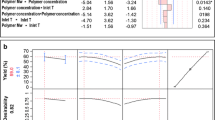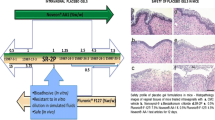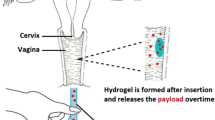Abstract
The intravaginal route of administration can be exploited to treat local diseases and for systemic delivery. In this work, we developed an alginate/chitosan membrane sufficiently stable in a simulated vaginal fluid and able to dissolve over time at a very slow and linear rate. The membrane demonstrated good mechanical properties both in its swollen and dry form. As a study case, we evaluated the viability of this potential drug delivery system for the treatment of bacterial vaginosis, a common disease affecting women in their reproductive age. Metronidazole was effectively included in the alginate/chitosan membrane and its bactericide effect was demonstrated against Staphylococcus aureus and Gardnerella vaginalis, simultaneously showing good biocompatibility with a cervix epithelial cell line. Since this alginate/chitosan membrane is stable in a simulated vaginal environment, is easy to fabricate and can be used for the controlled release of a model drug, it represents a promising drug delivery system for local intravaginal applications.









Similar content being viewed by others
Data availability
The raw/processed data required to reproduce these findings are available to download from https://zenodo.org/record/1418734#.W5uUR84zbDB (https://doi.org/10.5281/zenodo.1418734).
References
Pozzi F, Furlani P, Gazzaniga A, Davis S, Wilding I. The time clock system: a new oral dosage form for fast and complete release of drug after a predetermined lag time ★. J Control Release. 1994;31:99–108. https://doi.org/10.1016/0168-3659(94)90255-0.
Mazzoni C, Tentor F, Strindberg SA, Nielsen LH, Keller SS, Alstrøm TS, et al. From concept to in vivo testing: microcontainers for oral drug delivery. J Control Release. 2017;268:343–51. https://doi.org/10.1016/j.jconrel.2017.10.013.
Sacco P, Decleva E, Tentor F, Menegazzi R, Borgogna M, Paoletti S. et al. Butyrate-loaded chitosan/hyaluronan nanoparticles: a suitable tool for sustained inhibition of ROS release by activated neutrophils. Macromol Biosci. 2017;1700214:1700214. https://doi.org/10.1002/mabi.201700214.
Barenholz Y. Doxil®–the first FDA-approved nano-drug: lessons learned. J Control Release. 2012;160:117–34. http://www.sciencedirect.com/science/article/pii/S0168365912002301. Accessed 23 Feb 2015.
Lopes CM, Bettencourt C, Rossi A, Buttini F, Barata P. Overview on gastroretentive drug delivery systems for improving drug bioavailability. Int J Pharm. 2016;510:144–58. https://doi.org/10.1016/j.ijpharm.2016.05.016.
Hussain A, Ahsan F. The vagina as a route for systemic drug delivery. J Control Release. 2005;103:301–13.
Bigucci F, Abruzzo A, Vitali B, Saladini B, Cerchiara T, Gallucci MC., et al. Vaginal inserts based on chitosan and carboxymethylcellulose complexes for local delivery of chlorhexidine: preparation, characterization and antimicrobial activity. Int J Pharm. 2015;478:456–63. http://www.ncbi.nlm.nih.gov/pubmed/25490184. Accessed 9 Nov 2017.
Kenechukwu FC, Attama AA, Ibezim EC, Nnamani PO, Umeyor CE, Uronnachi EM, et al. Novel intravaginal drug delivery system based on molecularly PEGylated lipid matrices for improved antifungal activity of miconazole nitrate. Biomed Res Int. 2018;2018:1–8. https://doi.org/10.1155/2018/3714329.
Baloglu E, Senyigit ZA, Karavana SY, Bernkop-Schnürch A. Strategies to prolong the intravaginal residence time of drug delivery systems. J Pharm Pharm Sci. 2009;12:312–36. http://www.ncbi.nlm.nih.gov/pubmed/20067707.
Wang J, Wang Y, Wang Z, Wang F, He J, Yang X, et al. A thermosensitive gel based on w1/o/w2 multiple microemulsions for the vaginal delivery of small nucleic acid. Drug Deliv. 2019;26:168–78. https://doi.org/10.1080/10717544.2019.1568622.
Ceschel GC, Maffei P, Lombardi Borgia S, Ronchi C, Rossi S. Development of a mucoadhesive dosage form for vaginal administration. Drug Dev Ind Pharm. 2001;27:541–7.
Dobaria NB, Badhan AC, Mashru RC. A novel itraconazole bioadhesive film for vaginal delivery: design, optimization, and physicodynamic characterization. AAPS PharmSciTech. 2009;10:951–9. http://www.springerlink.com/index/10.1208/s12249-009-9288-0.
Reddy NHS, Patnala S, Löbenberg R, Kanfer I. In vitro dissolution of generic immediate-release solid oral dosage forms containing BCS class I drugs: comparative assessment of metronidazole, zidovudine, and amoxicillin versus relevant comparator pharmaceutical products in South Africa and India. AAPS PharmSciTech. 2014;15:1076–86. http://link.springer.com/10.1208/s12249-014-0135-6.
Dingsdag SA, Hunter N. Metronidazole: an update on metabolism, structure–cytotoxicity and resistance mechanisms. J Antimicrob Chemother. 2018;73:265–79. http://academic.oup.com/jac/article/doi/10.1093/jac/dkx351/4565576/Metronidazole-an-update-on-metabolism
Löfmark S, Edlund C, Nord CE. Metronidazole is still the drug of choice for treatment of anaerobic infections. Clin Infect Dis. 2010;50:S16–23. https://academic.oup.com/cid/article-lookup/doi/10.1086/647939.
Hay P. Bacterial vaginosis. Medicine. 2014;4:359–63. https://www.nichd.nih.gov/health/topics/bacterialvag/conditioninfo/Pages/symptoms.aspx. Accessed 3 Nov 2017.
Donders GGG, Ruban K, Bellen G. Selecting anti-microbial treatment of aerobic vaginitis. Curr Infect Dis Rep. 2015;17:1–7.
Schwebke JR, Muzny CA, Josey WE. Role of gardnerella vaginalis in the pathogenesis of bacterial vaginosis: a conceptual model. J Infect Dis. 2014;210:338–43.
Turovskiy Y, Noll KS, Chikindas ML. The etiology of bacterial vaginosis. J Appl Microbiol. 2011;110:1105–28.
Rossi S, Vigani B, Sandri G, Bonferoni MC, Caramella CM, Ferrari F. Recent advances in the mucus-interacting approach for vaginal drug delivery: from mucoadhesive to mucus-penetrating nanoparticles. Expert Opin Drug Deliv. 2019;16:777–81. https://doi.org/10.1080/17425247.2019.1645117.
El-Kamel A, Sokar M, Naggar V, Al Gamal S. Chitosan and sodium alginate—based bioadhesive vaginal tablets. AAPS PharmSciTech. 2002;4:224–30. http://link.springer.com/10.1208/ps040444.
Abruzzo A, Bigucci F, Cerchiara T, Saladini B, Gallucci MC, Cruciani F, et al. Chitosan/alginate complexes for vaginal delivery of chlorhexidine digluconate. Carbohydr Polym. 2013;91:651–8. https://doi.org/10.1016/j.carbpol.2012.08.074.
LIU P, KRISHNAN TR. Alginate-Pectin-Poly-L-lysine particulateas a potential controlled release formulation. J Pharm Pharm. 1999;51:141–9. http://www.ncbi.nlm.nih.gov/pubmed/10217312.
Patel N, Lalwani D, Gollmer S, Injeti E, Sari Y, Nesamony J. Development and evaluation of a calcium alginate based oral ceftriaxone sodium formulation. Prog Biomater. 2016;5:117–33. http://link.springer.com/10.1007/s40204-016-0051-9.
Agulhon P, Markova V, Robitzer M, Quignard F, Mineva T. Structure of alginate gels: interaction of diuronate units with divalent cations from density functional calculations. Biomacromolecules. 2012;13:1899–907.
Draget KI, Skjåk-Bræk G, Smidsrød O. Alginate based new materials. Int J Biol Macromol. 1997;21:47–55. http://www.sciencedirect.com/science/article/pii/S0141813097000408.
Mørch ÝA, Donati I, Strand BL, Skjåk-Bræk G. Effect of Ca2+, Ba2+, and Sr2+ on alginate microbeads. Biomacromolecules. 2006;7:1471–80.
Sogias Ia, Williams AC, Khutoryanskiy VV. Why is chitosan mucoadhesive? Biomacromolecules. 2008;9:1837–42.
Lawrie G, Keen I, Drew B, Chandler-Temple A, Rintoul L, Fredericks P, et al. Interactions between alginate and chitosan biopolymers characterized using FTIR and XPS. Biomacromolecules. 2007;8:2533–41.
Furlani F, Sacco P, Decleva E, Menegazzi R, Donati I, Paoletti S, et al. Chitosan acetylation degree influences the physical properties of polysaccharide nanoparticles: implication for the innate immune cells response. ACS Appl Mater Interfaces Am Chem Soc. 2019;11:9794–803.
Bierhalz ACK, Moraes ÂM. Tuning the properties of alginate-chitosan membranes by varying the viscosity and the proportions of polymers. J Appl Polym Sci. 2016;133:1–11. http://doi.wiley.com/10.1002/app.44216.
Caetano GF, Frade MAC, Andrade TAM, Leite MN, Bueno CZ, Moraes ÂM, et al. Chitosan-alginate membranes accelerate wound healing. J Biomed Mater Res. 2015;103:1013–22.
Wang L, Khor E, Wee A, Lim LY. Chitosan-alginate PEC membrane as a wound dressing: assessment of incisional wound healing. J Biomed Mater Res. 2002;63:610–8.
Owen DH, Katz DF. A vaginal fluid simulant. Contraception. 1999;59:91–5.
Ingar Draget K, Østgaard K, Smidsrød O. Homogeneous alginate gels: a technical approach. Carbohydr Polym. 1990;14:159–78.
Porrelli D, Travan A, Turco G, Marsich E, Borgogna M, Paoletti S, et al. Alginate-hydroxyapatite bone scaffolds with isotropic or anisotropic pore structure: material properties and biological behavior. Macromol Mater Eng. 2015;300:989–1000.
Jang J, Seol YJ, Kim HJ, Kundu J, Kim SW, Cho DW. Effects of alginate hydrogel cross-linking density on mechanical and biological behaviors for tissue engineering. J Mech Behav Biomed Mater. 2014;37:69–77. https://doi.org/10.1016/j.jmbbm.2014.05.004.
Sacco P, Cok M, Asaro F, Paoletti S, Donati I. The role played by the molecular weight and acetylation degree in modulating the stiffness and elasticity of chitosan gels. Carbohydr Polym Elsevier. 2018;196:405–13. https://doi.org/10.1016/j.carbpol.2018.05.060.
das Neves J, Amaral MH, Bahia MF. Performance of an in vitro mucoadhesion testing method for vaginal semisolids: Influence of different testing conditions and instrumental parameters. Eur J Pharm Biopharm. 2008;69:622–32.
Kong M, Chen XG, Xing K, Park HJ. Antimicrobial properties of chitosan and mode of action: a state of the art review. Int J Food Microbiol. 2010;144:51–63. https://doi.org/10.1016/j.ijfoodmicro.2010.09.012.
Baysal K, Aroguz AZ, Adiguzel Z, Baysal BM. Chitosan/alginate crosslinked hydrogels: preparation, characterization and application for cell growth purposes. Int J Biol Macromol. 2013;59:342–8. https://doi.org/10.1016/j.ijbiomac.2013.04.073.
Travan A, Marsich E, Donati I, Benincasa M, Giazzon M, Felisari L, et al. Silver-polysaccharide nanocomposite antimicrobial coatings for methacrylic thermosets. Acta Biomater. 2011;7:337–46. https://doi.org/10.1016/j.actbio.2010.07.024.
Acknowledgements
The authors would like to acknowledge the Danish National Research Foundation (DNRF122) and Villum Fonden (Grant No. 9301) for Intelligent Drug Delivery and Sensing Using Microcontainers and Nanomechanics (IDUN). The authors would also like to acknowledge Claudio Cecone, Nicola Labovitis and Ho Duy Khiet for their initial help during the 2017 Summer School in Drug Delivery held at the Technical University of Denmark. Nanna Bild, Technical University of Denmark, is acknowledged for the drawing of the schematics.
Author information
Authors and Affiliations
Corresponding author
Ethics declarations
Conflict of interest
The authors declare that they have no conflict of interest.
Additional information
Publisher’s note Springer Nature remains neutral with regard to jurisdictional claims in published maps and institutional affiliations.
Rights and permissions
About this article
Cite this article
Tentor, F., Siccardi, G., Sacco, P. et al. Long lasting mucoadhesive membrane based on alginate and chitosan for intravaginal drug delivery. J Mater Sci: Mater Med 31, 25 (2020). https://doi.org/10.1007/s10856-020-6359-y
Received:
Accepted:
Published:
DOI: https://doi.org/10.1007/s10856-020-6359-y




